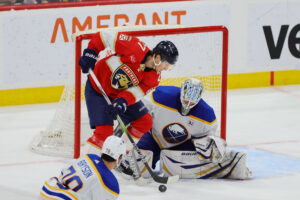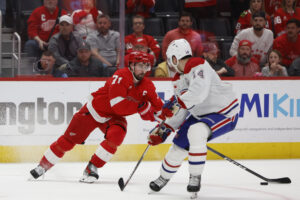A month of erratic play and mediocre results has let the Vancouver Canucks best line stand out. That line, of course, is Conor Garland centring Dakota Joshua and Teddy Blueger. You were expecting someone else, perhaps?
Canucks Best Line is What, Now?
Vancouver went 7-7 in the 14 games leading into Saturday’s match against the Carolina Hurricanes. They literally alternated wins and losses for ten games in a row. Those inconsistent results were caused, at least in part, to an ongoing flaw in the Canucks top two lines: They are regularly outplayed.
That isn’t to say their opponents had better results every time, because they don’t. Outscoring their problems has been a hallmark for Vancouver this year, averaging nearly four goals through 28 games. That’s top three in the league, bundled with the Los Angeles Kings and Detroit Red Wings. Sit that beside a top-five goals-against and they should have the record they do.
But lately, it hasn’t come so easily to them. A big part of that is some regression to the mean after a statistically freakish opening quarter, certainly. But watching coach Rick Tocchet juggle his lines to “get something going” is damning. Andrei Kuzmenko has been healthy scratched, Phillip Di Giuseppe is demoted from the second line, and Anthony Beauvillier is gone.
The consistent line for Vancouver has been their third. That’s the untouched trio of Garland, Joshua, and Blueger.
Yes, Them
Pre-Hurricanes, the three players had a grand total of eight goals between them. Eight goals and 21 points in – averaged out – 22 games is great for one player! It’s decent in support for two, a bit of secondary scoring from a couple bottom-six players. But it’s really not much for three, even if they’re not getting any power play time. So what gives? Why haven’t they been thrown in the line blender?
In a big way, scoring isn’t their job. Don’t get us wrong, it would be amazing for Garland to get back to his more typical 50-point pace. Or for Joshua to suddenly hit his potential. But Garland isn’t on the power play, and Joshua and Blueger both have penalty-killing duties. They’re good at it, too, limiting teams better than just about any other pairing Vancouver’s managed this season.
The Canucks erstwhile first line of Elias Pettersson – Ilya Mikheyev – Andrei Kuzmenko had scored 11 goals together but allowed 11 in return. The so-called second of J.T. Miller – Brock Boeser – Phil Di Giuseppe had also scored 11 as a unit and allowed eight.
Both of those are better than Joshua – Garland – Blueger getting two for and three against. And yet it’s these three left alone as changes happen to the others. Key here, in publicly available stats, is the opportunities that arise for them.
It’s The Canucks Best Line, of Corsi
Now, the number of shots a team takes isn’t always an indication of control. The visiting Hurricanes are a prime example, being a team that loves to launch shots from anywhere at any time. Goalies call this “warming up” rather than being actual threats to score. The Hurricanes have been better at choosing their spots this season, but that hasn’t always been the case.
That being said, a team needs to control the puck in the opposing zone before they can get shots off. And Vancouver’s third line – before Saturday’s match – attempted 91 shots and faced just 55. That’s a Corsi of well over 60%, and they take about a shot every minute they’re on the ice.
Those attacking numbers equal Vancouver’s top two lines. As for shots against, opponents are getting one every minute and a half. That far outstrips what the Canucks best give up. Even if the end result is low-event hockey, the team just needs their scorers to produce enough for a lead. They have a line the coach trusts to minimize damage – and for good reason.
A Complication – Maybe
Pius Suter is returning to the ice after a mystery ailment that’s kept him out since November 12th. In the original play, Suter was centring Joshua and Garland as Blueger took faceoffs on the fourth. Fortunately, Blueger has been able to step in and perform admirably in Suter’s absence. Should he be returned to the fourth after playing this well? Why break up what works?
Suter returning probably will move Blueger down and for good reason. Suter has a better history of producing at the NHL level than Blueger does, for a start. Suter’s hit double digits in goals in each of his three seasons and is probably a lock this year. Blueger hasn’t managed that yet in six seasons, even with 15+ minutes of ice time. The Canucks need more scoring from someone on the ice that much.
The defensive contributions of Blueger shouldn’t be ignored, of course. We just spent a heading cheering them, after all. What has Suter done to compare?
Here’s the thing: we can literally compare directly. The sample size for Blueger with Garland and Joshua was eleven games – the same as Suter with Garland and Joshua. And they did even better with Suter.
In about 15 fewer total minutes, the Suter combo managed 96 shots on net and limited opponents to just 53. They outscored opponents 3-0. Even in expected goals, Suter-Garland-Joshua has a 68.8% rate compared to Blueger-Garland-Joshua at a still excellent 61.7%.
Not everyone will agree that the mostly defensive line that scores rarely can ever be a team’s “best”. If one of your lines controls the play three-quarters of the time it’s on the ice, that’s pretty dang good. And if it’s the same line the coach refuses to break up, then we suggest that he agrees.
*All statistics coming from the tremendously useful MoneyPuck
Main Photo Credit: Simon Fearn-USA TODAY Sports






